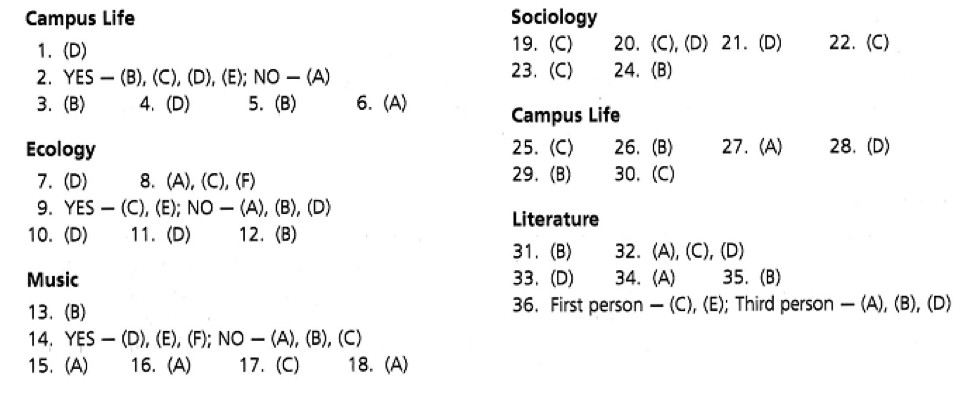TOEFL IBT Listening Practice Test 33 from Mastering Skills for TOEFL iBT Solution

——————————————————————————-
TOEFL IBT Listening Practice Test 33 from Mastering Skills for TOEFL iBT Transcripts
- Campus life
W: Hey Miguel, how’ve you been lately?
M: Stressed. My global government prof just gave us a monster project. We have to do online research and make a presentation using some kind of computer program. I have no idea about how to use that program. I’ve never even heard of it before. Say. you don’t know anything about how the computer labs work here, do you? I’ve never really had to do any assignments with computers before, so I’ve never been to the computer labs on campus.
W: Actually, I worked in one of the open labs for two semeste’s. What do you wanna know?
M: Wow, thanks, Jean. Where to begin… Well, first off, where are they?
W: Well the open labs are in the basement of the library, in the student union building, and then there are two more on campus. One in the science building and one In that other new building across campus, the building where they do freshman orientation.
M: Oh yeah. I know the one you’re talking about.
W: Anyway, the largest open computer lab is in the science building.
M: Oh, OK. Are they open 24 hours?
W: Unfortunately, no. They’re open from 8 a.m. to 9 p.m. Monday through Thursday, and 9:00 to 5:30 on Friday. The good news is that during the fall and spring semesters, they’re open Saturdays and Sundays as well. They’re open 9:00 until 5:00 during the weekend.
M: Uh huh, and do they offer any kind of training on the computers? Like I said, I don’t know much about computers.
W: Yes, they do actually. They hold computer training workshops twice a month. You can sign up for one in the library. There are also instructional tutoring sessions for students who need help with their course work in the science computer lab, and of course, individual assistance in all of the labs.
M: Can I just walk in and start using a computer, or do I need a password or something?
W: You don’t need a password to walk in the door, but you will need one to log in and use a computer. You have a student email account, don’t you?
M: Sure. Doesn’t everybody?
W: Everybody could have one, but some people don’t actually make use of the free service offered by this university. They’d rather pay an online company for some reason,
M: That’s nutty.
W: I think so, too. Anyway, I was asking you about your email account because that’s how you can get a password. You have to register with the computer administration office on campus. They’re the ones who send you the password.
M: This is getting complicated.
W: It’S not really, It just sounds daunting if you’ve never done it before. Hey, do you have some time right now? I can go with you and help you register for a password.
M: As a matter of fact, mv next class doesn’t start until 3:30.
W: How about going to the computer lab in the student union? That’s the closest one.
M: Lead the way. I’m right behind you.
——————————————————————————-
02 Ecology
M: I’m sure a lot of you in this class have your own car. Think about the dashboard of your car. There are some special indicator lights there, warning indicators. If something is wrong with your car, those indicator lights will come on to warn you. Well, today we’re going to talk about a similar kind of indicator in nature. Tiiese are bio-indicators. A bio-indlcator is an organism that can warn us about harmful changes in our environment. The typical example of a bio-indicator would be a miner’s canary. Miners today don’t use them, but anyway, it’s a good example from history.
I’m not sure how much you know about mining, You might have heard about recent mining accidents in the news. Obviously, this is a dangerous occupation, but other than mine collapses or explosions, another danger for miners is gas. I mean natural gas in the air, that you can’t see. Pockets of natural gas sometimes occur naturally in mine-shafts. These pockets of gas are difficult to detect and can suffocate and kill miners if they do not notice them. You might not realize It, but natural gas doesn’t actually have a smell, or at least it doesn’t smell like the stuff you put in your car at the gas station. So, when a miner is working In a cave where there is a lot of natural gas in the air – weli, you can imagine it’s not a good situation to be In. So, miners used to take canares Into the mines with them. A canary is quite small, and these birds will pass out long before a human In a gas pocket. So, if the miner notices that the canary passes out, the miner knows there is danger and that he has to get out of that part of the mine immediately. In this case, the canary is more sensitive to a problem in the environment — the mine in this case – than humans. Likewise, bio-indicators tell us about potential problems in our environment because they are more sensitive to It than we are. OK, quiz time. Can anyone think of another example of a bio-indicator? Yes, Carol?
W: Those frogs that were deformed because of the pollution?
M: Good example. Frogs breathe through their skin. This means that they directly absorb everything in the water and air they live in, making them much more easily affected by pollution than humans are. When we notice a population of frogs with lots of deformities, such as extra legs, missing body parts, or malformed parts, we know that the area has probably been polluted, that the appropriate testing needs to be performed, and the necessary precautions need to be taken. And, as Carol mentioned, we’ve seen this happen right here in the United States.
OK, so we see that pollution hurts frogs, but what about people? Is there any evidence to suggest this kind of pollution causes problems for humans, too? To answer this question, we need to take a look at human bio-indicators.
Who might be a human bio-indicator? People who are more sensitive to the environment. In particular, children and unborn babies, or fetuses, are more sensitive to pollution than full-grown adults. So, they can also tell us about our environment. We usually Ignore bio-indicators like frogs because, well, they’re just frogs, aren’t they? But when there are health problems in human communities, that sure catches our attention I Here’s a good example. No doubt you guys are all too young to remember this, but when I was growing up, this was a big deal and everybody knew about It. In 1978, there was a serious health problem. In Love Canal, a suburban neighborhood in upstate New York. There was a high rate of cancer among the children of the area, birth defects were increasing, and pregnant women were losing their babies. Because of the high rate of birth defects and pregnancy problems, people in the area began asking the government to find out why. There was actually a group of activists at the time who were using the slogan, “Our fetuses are our canaries.”
So, what was it about Love Canal that made it different from healthy communities? Well, as it turns out, from 1920 until 1953, the site was used as a chemical dump, a place where a company buries its chemical wastel. The dump was later filled In with dirt before It was sold as regular real estate. Of course, chemicals in the ground get washed into ground water supplies when it rains, and the ground water eventually finds its way Into local city water systems.

